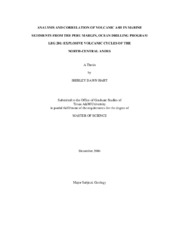| dc.description.abstract | A detailed investigation of cores from three Peru Margin sites drilled during Ocean
Drilling Program (ODP) Leg 201 has been conducted to determine the occurrence of
volcanic ash layers and ash accumulations within marine sediments along the Peru shelf.
These sites were previously occupied during ODP Leg 112, which suffered from poor
and/or disturbed recovery. Advancements in hydraulic piston coring realized since and
employed during ODP Leg 201 resulted in better core recovery and less disturbance of
sediment throughout the cored intervals. Since marine sediments potentially undergo
less erosion and Leg 201 cores benefited from improved recovery, the tephrachronologic
record from Leg 201 has yielded a more complete record of explosive activity for North-
Central Andean volcanism than previous studies.
The improved recovery of Leg 201 cores has enabled the detailed examination of cores
from the above sites needed to test the hypothesis that volcanic ash layers and
accumulations are more abundant in the study region than previously reported. Due to the low recovery of Leg 112 cores, Pouclet et al. (1993) document only six-ash layers,
one ash pod, and eight ash-bearing layers (for a total of 14 cm of ash) from the three
sites (Sites 684, 680, and 681) that were reoccupied during Leg 201 (Sites 1227, 1228,
and 1229 respectively). This study reports a total of 332.0 cm of ash deposited into the
study region which is approximately 24 times that previously reported.
Explosive eruption cycles for the Andean region have been deduced from the
documentation of Leg 201 ash layers. Our record of volcanic cycles indicates that
explosive activity was less intense during the Miocene, in which one ash layer (1.3 cm)
was deposited, compared to that of the Pliocene and Pleistocene which experienced most
of the explosive volcanic activity in which 52 ash layers (total thickness equal to 208.6
cm) and 14 ash layers (total thickness equal to 122.1 cm) were deposited respectively
(Fig. 14). These data are consistent with the previous study of Pouclet et al. (1990);
however these data indicate that explosive activity during the Pliocene and Pleistocene
was more intense than previously reported. | en |


